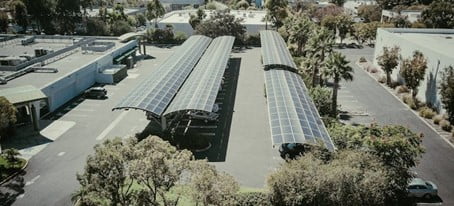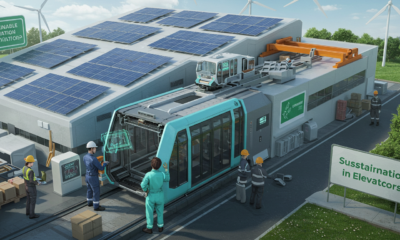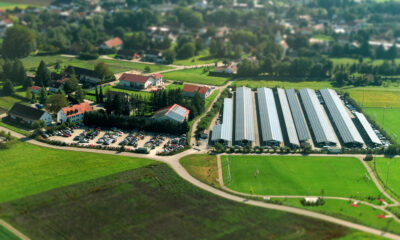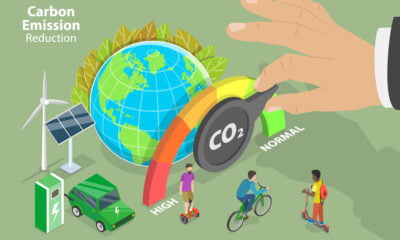

Energy
Solar-Powered Solutions for Lowering City Infrastructure Carbon Footprint
In our collective efforts to combat climate change, individual actions, from eco-friendly shopping habits to diligent recycling, undoubtedly play a role. However, as cities continue to expand and urbanize, the need for substantial changes on a larger scale becomes increasingly evident. This is where solar-powered solutions in city infrastructure emerge as key players in the quest for sustainability.
Harnessing the sun’s abundant energy helps cities significantly reduce their carbon footprint and pave the way toward a greener future. From illuminating streets with solar-powered lights to revolutionizing public spaces with solar technology, these innovations showcase the potential for transformative change in urban environments.
Illuminating Streets with Solar Street Lights
As cities strive for sustainability, solar street lights are becoming a popular solution for eco-friendly urban infrastructure. Unlike their traditional counterparts, solar street lights harness renewable energy from the sun. This drastically reduces installation and operational costs while minimizing environmental impact. On the other hand, conventional street lights rely on grid electricity and encounter high maintenance expenses. Because of that, solar street lights present a cost-effective and sustainable alternative.
Installation is simple, with no need for extensive wiring or trenching, making them ideal for remote or off-grid locations. Likewise, solar streetlights operate autonomously. They rely solely on solar energy, thereby eliminating electricity bills and reducing carbon emissions. All of this makes the choice between solar street lighting vs. traditional street lights clear. Solar-powered solutions illuminate streets efficiently and pave the way toward greener, more resilient cities.
Harnessing Solar Energy for Public Buildings
In the era of sustainable construction practices, construction companies are increasingly embracing renewable power sources. As a result, solar energy is leading the charge in powering public buildings. By integrating solar panels into the infrastructure of public buildings such as libraries, community centers, and schools, cities can significantly reduce their carbon footprint while promoting energy efficiency and cost savings.
These solar-powered public buildings exemplify sustainable urban development, demonstrating a commitment to environmental resilience. With advancements in solar technology and decreasing installation costs, the adoption of solar energy in public buildings is becoming more achievable and widespread.
For example, Hawaiian schools are starting to rely on solar energy for their energy supplies. A good Hawaiian commercial solar provider offers financing options and installations to the schools’ sites to help reduce the carbon footprint, improve energy conservation, and lower costs.
For instance, installing solar panels on buildings allows cities to reduce carbon footprint while maximizing space efficiency. So, from powering lighting and HVAC systems to providing backup power during outages, solar energy is vital in enhancing the sustainability and resilience of urban infrastructure.
Revolutionizing Transportation with Solar-Powered Bus Stops
Solar-powered bus stops have emerged in recent times, ready to transform public transportation infrastructure as we know it. What makes them different than their regular counterparts is that they come equipped with integrated solar panels that allow communities to harness renewable energy, thereby reducing reliance on grid electricity and lowering carbon emissions.
Solar-powered bus shelters have certainly proved to be a sustainable solution for bus stops. But at the same time, they have become an extremely convenient alternative to traditional bus stops. This is because, first of all, they provide a comfortable and well-lit waiting environment. Furthermore, since they operate on nothing but solar energy stored in batteries, they ensure uninterrupted functionality even in areas with limited access to conventional power sources. And since they typically feature real-time bus tracking, lastly, they drastically improve the overall passenger experience by minimizing the frustration of not knowing the exact time the bus will arrive.

Solar-Powered Traffic Management Systems
In urban areas, solar-powered traffic management systems are becoming an excellent option to enhance efficiency and sustainability. By harnessing solar energy to power traffic lights and other critical systems, cities can significantly reduce their carbon footprint while ensuring reliable traffic flow. Conventional systems are reliant on grid electricity. Unlike them, solar-powered traffic management offers autonomy and resilience, even in the face of power outages.
These systems minimize operational costs and contribute to safer and more eco-friendly transportation networks. With advancements in solar technology and the increasing emphasis on sustainable urban planning, the adoption of solar-powered traffic management systems is on the rise. From reducing energy consumption to enhancing traffic safety, these innovative solar-powered solutions exemplify the intersection of technology and sustainability in shaping the cities of tomorrow.
Enhancing Parks and Recreational Areas with Solar Technology
Parks and recreational areas are transforming into sustainable havens with the integration of solar technology. Using solar energy to power amenities such as lighting, charging stations, and water features, cities can create environmentally friendly spaces promoting leisure and relaxation. These enhancements reduce reliance on traditional energy sources and contribute to the conservation of natural resources.
Solar technology can provide illuminated pathways for safe evening strolls, offer convenient charging stations for electronic devices, etc. As a result, these solutions enhance the overall visitor experience in parks and recreational areas. With sustainability becoming a key consideration in urban planning, adopting solar technology in parks signifies a commitment to environmental management.
Empowering Communities with Solar-Powered Public Spaces
Embracing sustainability at the grassroots level, solar-powered public spaces are becoming catalysts for community empowerment and the environment. From solar benches offering convenient charging stations to vibrant outdoor classrooms illuminated by solar-powered lights, these innovative spaces have the potential to reshape the urban landscape. When they utilize renewable energy sources, communities reduce their carbon footprint and foster a sense of ownership and responsibility toward the environment.
Through engaging in the design and utilization of these spaces, residents become active participants in the journey toward a greener future. From community gatherings to educational workshops, solar-powered public spaces provide platforms for fostering connections, raising awareness, and inspiring positive change.
Paving the Way Toward a Greener Tomorrow with Solar-Powered Solutions
Integrating solar technology into city infrastructure presents a transformative opportunity for reducing carbon emissions and promoting sustainability. From illuminating streets with solar-powered lights to revolutionizing transportation with solar bus stops, these innovations exemplify the potential for greener urban environments. Embracing solar-powered solutions enables cities to enhance efficiency, lower operational costs, and demonstrate a commitment to environmental preservation.
Meta description: Discover how solar-powered solutions can transform city infrastructure, reducing carbon footprint effectively!


 Environment9 months ago
Environment9 months agoAre Polymer Banknotes: an Eco-Friendly Trend or a Groundswell?

 Environment11 months ago
Environment11 months agoEco-Friendly Home Improvements: Top 7 Upgrades for 2025

 Features8 months ago
Features8 months agoEco-Friendly Cryptocurrencies: Sustainable Investment Choices

 Features9 months ago
Features9 months agoEco-Friendly Crypto Traders Must Find the Right Exchange





























